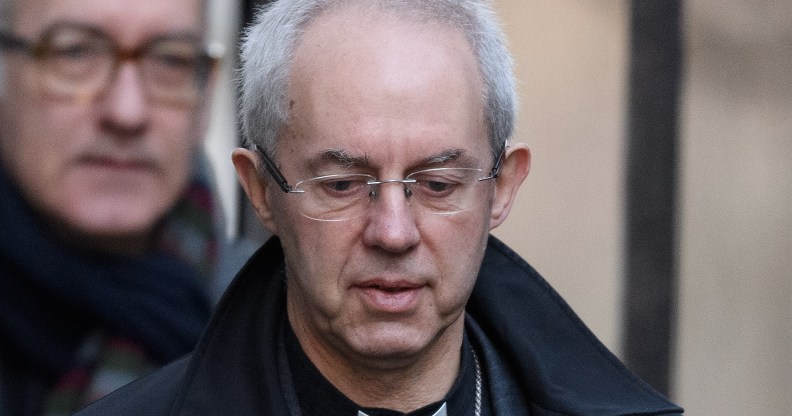Thousands tell Church of England to drop trans guidance

Justin Welby, the Archbishop of Canterbury. The Church of England said it would give the letter “serious consideration.” (Leon Neal/Getty)
More than 2,400 Church of England clergy and lay members have called modern developments in treating gender dysphoria “controversial” and “highly contested” in a letter criticising the church’s recent guidance on baptisms for transgender people.
In an open letter responding to the House of Bishops’ recent pastoral guidance, church clergy and lay members said the guidance doesn’t take into account the “wider medical, social and political debate” around transitioning.
The letter states: “There is widespread concern at the idea of biological males claiming to be women when they have not shared their personal and social experience … [T]here are concerns about the long-term effects of ‘puberty blocking’ hormones given the poor quality of the research; and there is no scientific or medical consensus that surgical and medical interventions (‘gender transition’) effectively address the complex symptoms associated with gender dysphoria over the long term.”
The signatories also claimed that holding baptism services recognising a person’s transition “appears to be based on the rejection of physical differentiation between male and female,” a belief that has “been the basis of the Church’s understanding of Christian marriage, is seen as an important feature of God’s work as creator, and is a symbol of God’s covenant relationship with humanity.”
Church of England’s guidance for trans baptism services
In December, the Church of England issued guidance on how the clergy can support transgender people who want to have a baptism.
The document suggests a standard service for trans people who haven’t been baptised. For those who have been baptised, it states that the rite of Affirmation of Baptismal Faith should be “the central feature of any service to recognise liturgically a person’s gender transition.”
It also says that “the Church of England welcomes and encourages the unconditional affirmation of trans people.”
The guidelines were created after the General Synod of the Church of England passed a motion in July 2017 to “welcome and affirm” trans people and called for “the preparation of liturgical materials to mark a person’s gender transition.”
William Nye, Secretary to the House of Bishops, emphasised earlier this month that the document on trans baptisms was “guidance, not a new set of rules.”
He added: “Any priest who feels unable to offer this rite in this context is free not to do so. They should find appropriate ways to offer welcome and pastoral care, as they would to all people.”
Church of England members question trans guidance
However, the 2,400-plus clergy and lay members have called for the House of Bishops to “revise, postpone or withdraw this guidance.”
They said that while the guidance is “undoubtedly well intentioned,” it “lacks the serious theological analysis required to address the philosophical, anthropological and social issues” around medical developments in transitioning, including hormone blocking medication and gender confirmation surgery.

The Church of England members’ letter has been criticised for its statements on trans people (Dan Kitwood/Getty)
Recent studies have found positive correlations between modern transitioning methods and the overall health of transgender youth.
A study released in 2017 by University of Washington researchers showed that letting trans kids socially transition prevents depression and anxiety. A study published in the Journal of Adolescent Health last year found that trans children who use their chosen name are 65 percent less likely to attempt suicide.
Church of England members react to trans letter
One person who signed the letter, Reverend Ian Paul, told The Guardian that the guidance is an example of the Church of England “allowing themselves to be hijacked by these very small special interest groups”—an apparent reference to trans campaigners.
“The fact that so many, from a wide range of traditions in the church, have been prepared to put their heads above the parapet is an indication of the strength of concern expressed here,” said Paul.
However, the letter has also been criticised for scaremongering around gender dysphoria and transitioning.
Trans clergy member Tina Beardsley said that the baptism guidelines “arose from a decision at the general synod which was passed by an overwhelming majority. The signatories to the letter can’t accept this decision.
“The advice is to use the affirmation of baptismal faith service to reaffirm someone’s faith post-transition with the name they have adopted. That’s all we’re talking about.”
“There is an anti-trans narrative in this letter which is unhealthy, stigmatising and fear-mongering,” Beardsley added.
A spokesperson for the Church of England said: “The bishops will give the letter their serious consideration, especially in the context of the preparation of a major new set of teaching and learning resources on identity, relationships, marriage and sexuality, ‘Living in Love and Faith,’ which will be published next year.”
The spokesperson made it clear that the baptism guidelines did not represent a new approach to trans people.
“The guidance is not a restatement or a new statement on matters relating to gender, nor does it change the C of E’s teaching,” they said.

